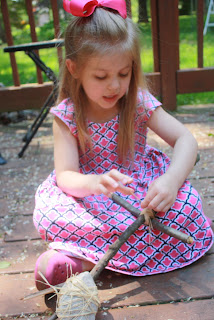We learned about nomads during our second week of study. The first part of the week we learned about what kinds of food nomads ate (anything they could find), where they slept (tents or caves depending on the climate), and why they moved so frequently (to find food and shelter). The second part of the week was dedicated to learning how nomads began to settle and become farmers. Part of this was learning about early irrigation systems such as the Shaduf which made it possible to grow crops. The farmers would dig canals from the river and use this lever system to irrigate their crops. We decided to try our hand at building a Shaduf of our own. I began by having the girls clear the sand from a portion of our sand/water table to create the canal.
The girls then decided our hose was the Euphrates river and used it to fill their newly created canal
Next we headed into the yard to locate a rock to serve as the weight for our Shaduf as well as sticks to build the rest of the system.
The girls located sticks in a Y shape to serve as the supports. They filled small cups around their bases to anchor them.
Next (with my assistance) they tied the rock they had found to serve as a weight to one end of their lever
They also used twine to connect the two sticks to finish the lever
Next we tied a small plastic bucket to the end of our lever to retrieve the water. At first I felt guilty about the plastic bucket but I didn't have any leather animal pelts lying around to create a water tight bag... Then I thought, hey, they used whatever they could find and what we can find is a small plastic bucket! So while the actual result may not have been completely authentic the spirit was!
We decided to use our Shaduf to water the vegetables we had planted several weeks earlier. They were easy to move to the sand table and it seemed appropriate given that we were building this as a way to explore early farming techniques.
We also learned that once nomads settled and became farmers they began to build more permanent structures for homes. We learned they frequently used mudbricks to build their homes. Although I hadn't planned it, somewhere near the end of watering our veggies with our Shaduf one of the girls asked if we could make a mudbrick house. That sounded like a great idea to me so I gave them each a measuring cup to help shape their blocks and away they went. They had to experiment a bit with the sand to water ratio to get their bricks to hold together. In all honestly I probably should have let them experiment with that process a bit more and directed much less, but we had a limited amount of sand (compared to water) and I didn't want to end up with them being a complete water/sand mess as we had somewhere else to be later in the day.
We used sticks across the top and then added more bricks to create a roof
The girls with their version of an ancient mudbrick house


















No comments:
Post a Comment